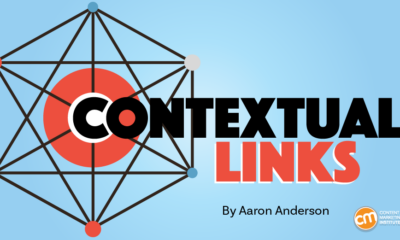SEO
Copywriting vs. Content Writing: Differences & Similarities

Writing is the lifeblood of most online businesses. Whether that’s blog articles, landing page copy, or product descriptions, the written word is necessary to attract and convert readers.
But there are two types of writers you can become (or hire): A content writer or a copywriter.
What are the differences between these two crafts? Which should you learn to do or hire for your business? Let’s take a look.
Content writing is, well, writing content—typically to inform or entertain the reader.
Examples of content writing include:
Copywriting is tweaking written content to persuade the reader to take action, such as making a purchase or signing up for a newsletter.
Examples of copywriting include:
- PPC ads
- Landing page copy
- Product descriptions
While the goal of content writing is to inform or entertain and the goal of copywriting is to sell, they go hand in hand. You typically want to be skilled at both, regardless of your goal.
That said, there are places where copywriters and content writers differ:
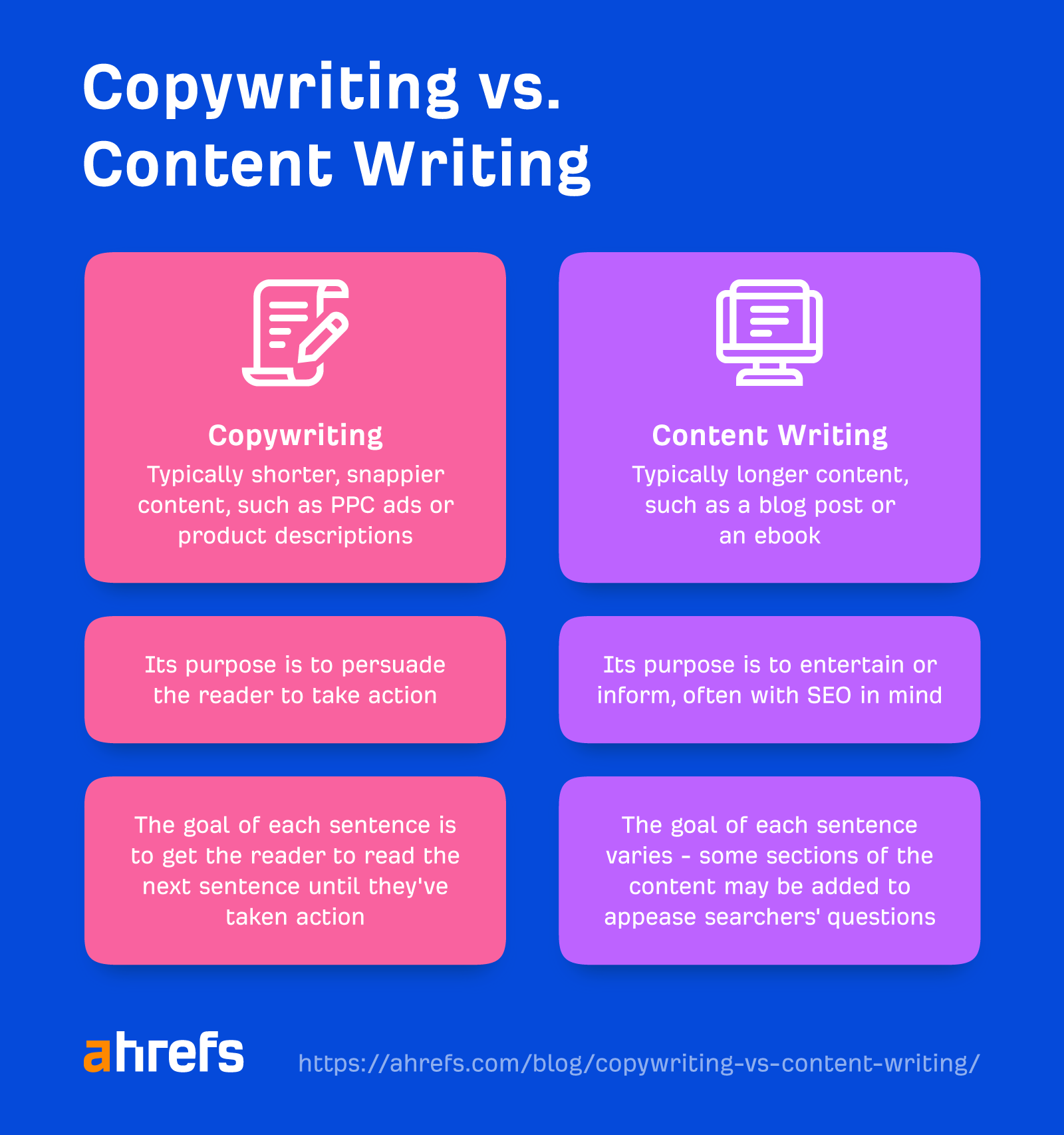
Length of content
Traditional content writers typically write longer content that’s 1,000 words or more. They are usually hired to write long-form blog articles, ebooks, or email newsletters.
Traditional copywriters write short, snappy content that’s just a few hundred words. They are usually hired to write short-form advertorials or product descriptions.
That said, content writers can write short-form content like social media posts and copywriters can write long-form content like landing pages. These are generalities, not hard rules.
Purpose
Traditional content writers are often hired to create blog content with the goal of ranking high on Google. They are often well versed in on-page SEO and organic social media.
Traditional copywriters are often hired to write ads, product pages, and landing pages. They know how to use powerful wording to get the reader to take action.
Again, however, these are generalities. There is such a thing as SEO copywriting where you combine these two disciplines to both rank well on Google and also get people to purchase your products or services.
Great content—and great copy—both do three things well:
- Entice the reader to keep reading
- Solve a need for the reader
- Give Google something worth displaying
Let’s talk about these.
Great content is enticing
Interesting, captivating, enticing—if these words don’t describe your writing, it needs editing.
How do you make your content more enticing? By:
- Knowing your audience.
- Being concise in your wording.
- Writing in a conversational tone.
- Editing, editing, and editing some more.
- Mastering transitions and emotional wording.
I wrote a whole guide to becoming a better writer, which I recommend you read to learn more.
Great content solves a need
I mentioned you must know your audience to write great content; part of that means knowing the problems they have and how your product or service solves those problems.
I don’t mean the superficial problem, though—people don’t often buy a T-shirt to stay warm. They buy a T-shirt to support their favorite group, show off their interests, find like-minded people, or feel more attractive and confident.
You must uncover the underlying problem your target market has. Also, show what you have to offer and how it solves that underlying problem.
For example, clothing brand Bombas talk about the exact problems its socks solve, not just that they’re comfortable:

Great content is optimized for search engines
Even though I said SEO is typically pursued by content writers over copywriters, both can benefit from learning it—and charge more too.
Search engine optimization is the process of creating content that is optimized to rank on Google for a particular keyword. While there’s a lot to learn about SEO writing, it boils down to:
- Doing keyword research to determine the best target keyword for a page.
- Knowing the search intent for that keyword, i.e., what is the searcher truly looking for?
- Understanding and implementing on-page SEO.
For example, this page targets the keyword “copywriting vs content writing.”
We found this keyword through keyword research. We chose it because it gets reasonable traffic and has a relatively low Keyword Difficulty (KD) score, according to our Keywords Explorer tool.

Next, we looked at the search intent for this keyword by reviewing the competing pages in the search results. I found that most searchers seem to be looking for information on the differences between the two in order to choose a career path or make a hiring decision—so that’s what I focused this article on.
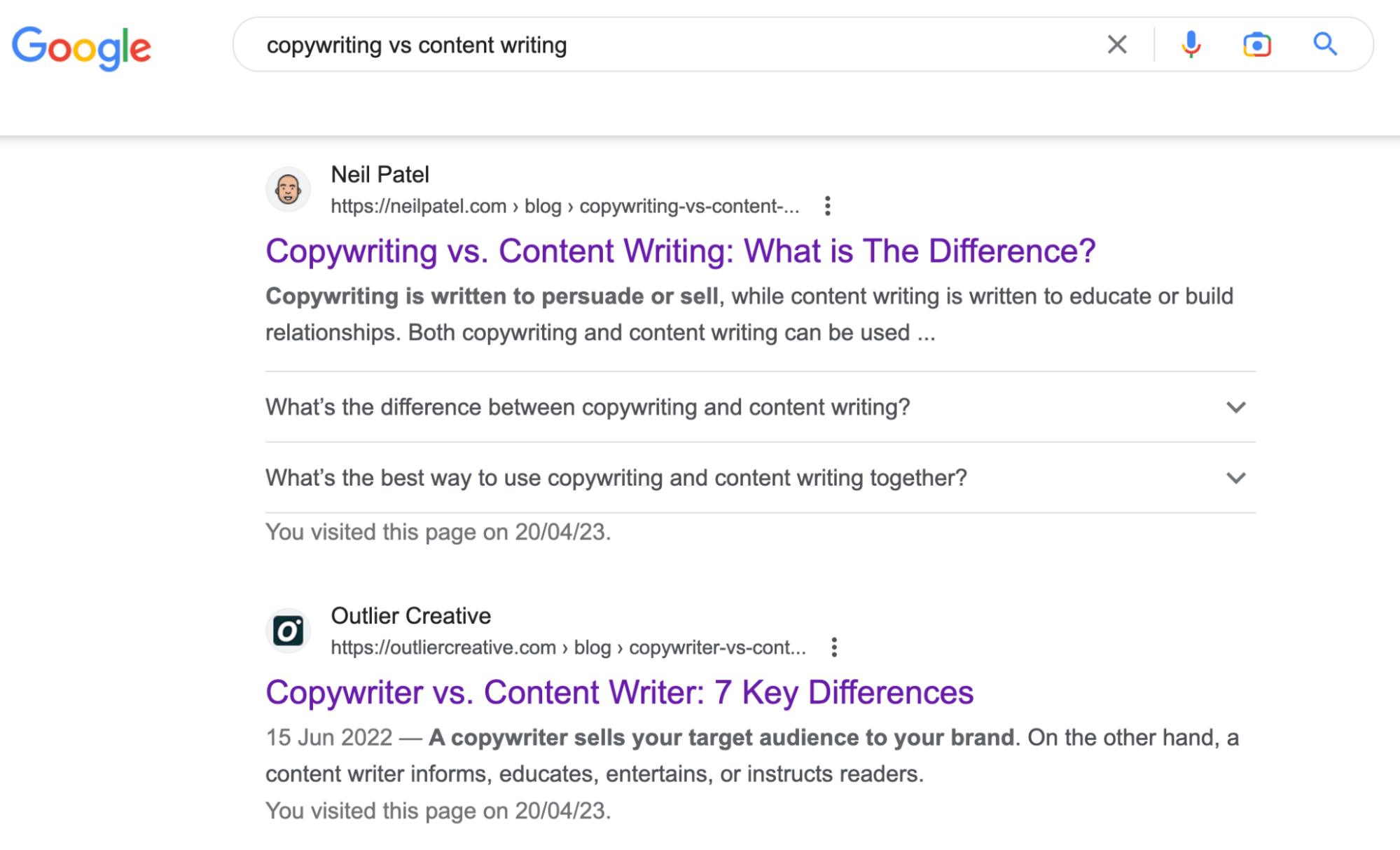
Finally, to help with on-page SEO, I looked at the People Also Ask box on Google. I’ve included answers to some of these common questions within this article:
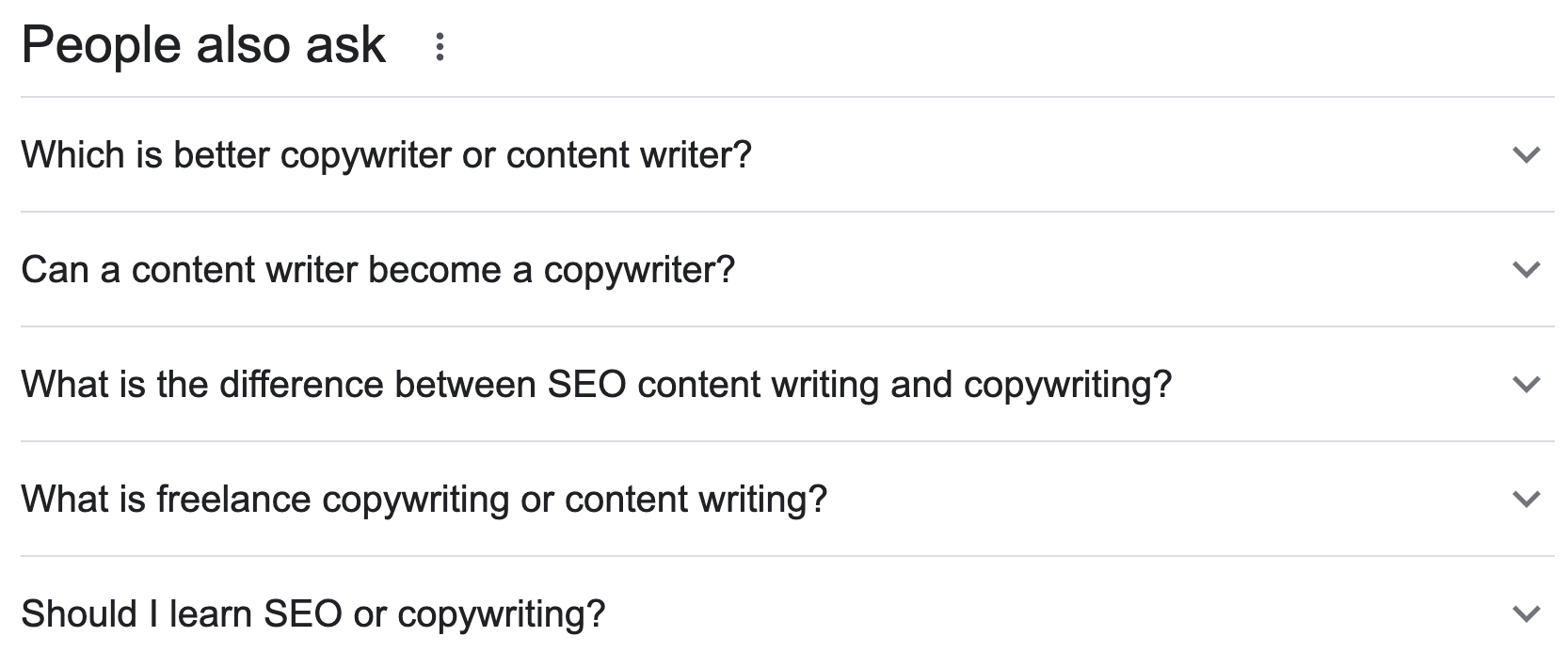
Of course, there’s more to SEO than just what I’ve shared here. Go read our beginner’s guide to SEO to learn more.
According to Indeed, the average content writer’s salary in the U.S. is $56,076 per year. Compare that with the average copywriter’s salary of $58,560 per year.
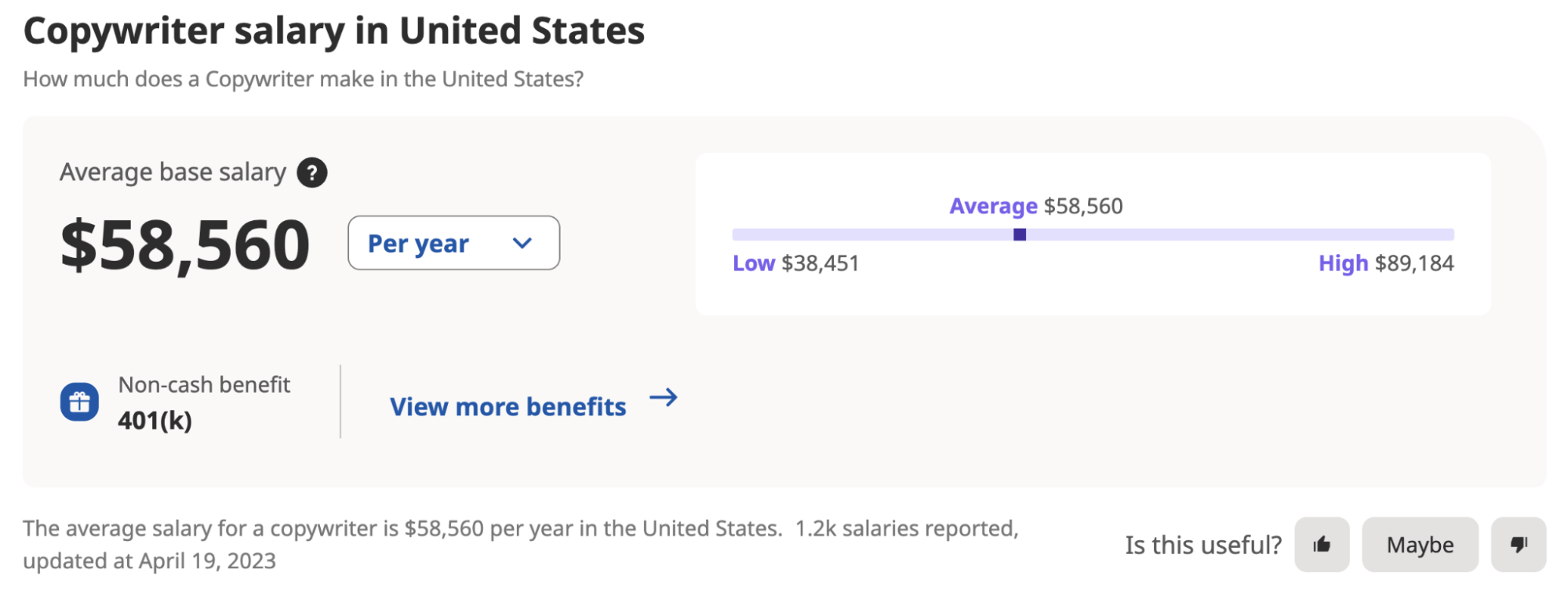
Copywriting tends to pay more than content writing because it’s easy to see the immediate impact of good copy on a company’s bottom line.
Think about it. Say you hire a person to write copy. The copy they wrote then immediately increases your conversion rate by 2% and puts an extra thousand dollars in your bank account.
You’d pay them more, wouldn’t you?
Compare that to hiring a content writer who writes a blog article for you, which you aren’t sure whether or not the article did or will make you money back. It’s easy to see why copywriters make more money than content writers.
That said, I have never advertised myself as a “copywriter.” I also make far more than a typical copywriter for writing content. That’s because I understand SEO and marketing as well, and the articles I write for my clients typically make their way to the top of Google’s search results.
Also, I understand both copywriting and content writing, which allows me to charge more.
Keep in mind that my first-ever freelance writing gig made me a measly $5 for a nearly 3,000-word article. So know that it takes time to learn the skills—both writing skills and being able to market yourself—to reach higher pay.
If you’re here wondering who you should hire—a copywriter or a content writer—the answer isn’t totally black and white.
If you want someone to write product descriptions, landing page copy, or copy for PPC ads, consider a copywriter. If you want someone to write blog posts, email newsletters, or ebooks, hire a content writer.
But honestly, the words “copywriter” and “content writer” are just different titles for what is basically the same job—putting words on a screen that inform, entertain, and ultimately get people to find and want to buy from your brand.
My suggestion is to look for a copywriter with SEO skills. They will be the most expensive but also (hopefully) the most helpful hire for your business.
Check out my guide to hiring an SEO team for more insight.
Final thoughts
Copywriting and content writing have their differences on paper. But ultimately, they’re just titles.
The true difference is whether the person who claims a title is actually a skilled writer in the industry they are advertising themselves. If they are, their title doesn’t matter, and they will be an asset to your business.
Questions or comments? Ping me on Twitter.
SEO
Chatbots And AI Search Engines Converge: Key Strategies For SEO

A lot is happening in the world of search right now, and for many, keeping pace with these changes can be overwhelming.
The rise of chatbots and AI assistants – like ChatGPT and its new model GPT-4o, along with Google’s rollout of AI Overviews and Search Generative Experience (SGE) – is blurring the lines between chatbots and search engines.
New AI-first entrants, such as Perplexity and You.com, also fragment the search space.
While this causes some confusion and necessitates that marketers pivot and optimize for multiple types of “engines,” it also presents a whole new array of opportunities for SEO pros to optimize for both traditional and AI-driven search engines in a new multisearch universe.
This evolution raises a broader question – perhaps for another day – about redefining what we call SEO to encompass terms like Artificial Intelligence Optimization (AIO) and Generative Engine Optimization (GEO).
Currently, every naming convention seems subject to change, which is something to consider as I write this article.
Either way, this evolution opens up tremendous opportunities for disruption in the overall search landscape.
What Is A Chatbot Or AI Assistant?
At the most basic level, chatbots use natural language processing (NLP) and large language models (LLMs) that are trained to extract data from online information, sources, and specific datasets. They then classify and fine-tune text and visual outputs based on a user’s prompt or question.
Chatbots are often used within specific applications or platforms, such as customer service websites, messaging apps, or ecommerce sites. They are designed to address specific queries or tasks within these defined contexts.
Right now, we see many crossovers between LLM-based chatbots and search engines. Rapid developments in these areas can cause confusion.
In this article, we’ll focus on the development of AI models in chatbots and their relation to search, with an inferred reference between chatbots and AI assistants.
The Evolution Of Chatbots And AI Models
Since ChatGPT emerged in November 2022, we’ve seen a significant boom in chatbots and AI assistants. Now, generative AI allows users to interact directly with AI and engage in human-like conversations to ask questions and complete various tasks.
For example, these AI tools can assist with SEO tasks, create content, compose emails, write essays, and even handle coding and programming tasks.
As they evolve, chatbots become multimodal (MMLLMs), improving capabilities beyond text to include images, audio, and more.
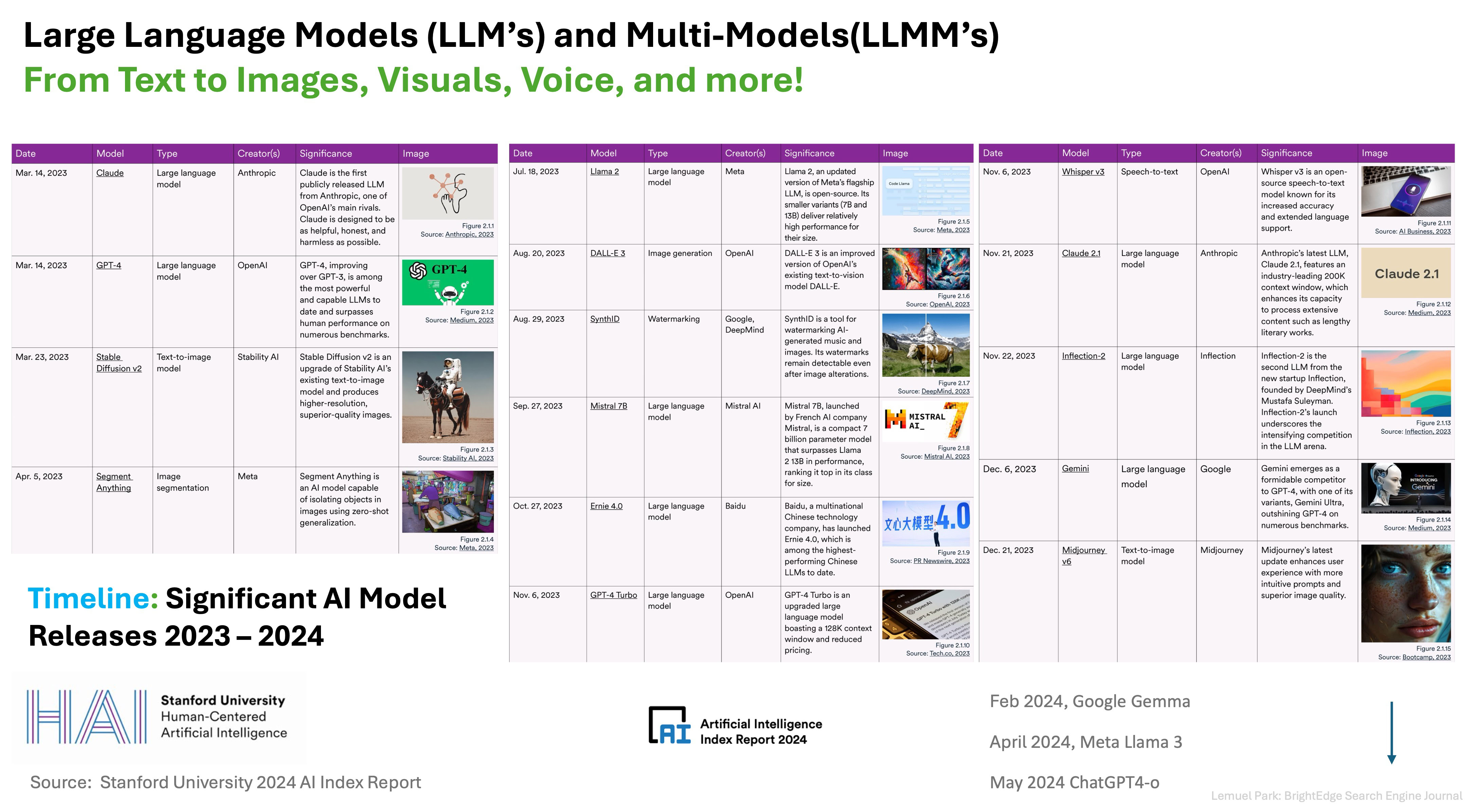 Image from 2024 AI Index Report from Stanford University, May 2024
Image from 2024 AI Index Report from Stanford University, May 2024For those interested in digging deeper into these models, the 2024 AI Index Report from Stanford University is a great resource for SEJ readers.
While many chatbots and AI models serve similar purposes, they also have distinct applications and use cases, such as content creation, image generation, and voice recognition.
Here are a few examples with some interesting differentiators and points:
- ChatGPT: Conversational AI for research, ideation, text, image content, and more.
- Google Gemini and Gemma: Uses Google’s LLM to connect and find sources within Google.
- Microsoft Bing: Uses ChatGPT for conversational web search in Bing.
- Anthropic Claude: Various AI models for content generation, images, and coding.
- Stability AI: Suite of models and AI assistants for text, image, audio, and coding.
- Meta Llama3: Utilizes Facebook’s social graph, its own Llama 3 model, and real-time data from Google.
- Microsoft’s Copilot: AI assistant for business creativity and productivity apps.
- Amazon LLM and Codewhisperer: Enhances customer and employer experiences.
- Perplexity AI: Provides quick answers, sources of information, and citations.
Perplexity AI (which I will touch on later in this article) acts more like a search engine than many other chatbots and AI assistants.
Beyond their primary use cases, many companies are making their models available to a wider audience and broader ecosystems, allowing users to customize their own AI assistants.
For example, Amazon’s Bedrock enables AWS customers to use Anthropic and other LLMs, including Amazon’s own model, to create custom AI agents. Companies like Lonely Planet, Coda, and United Airlines are already using it.
On May 13, OpenAI launched its new flagship model, GPT-4. This model is a combination of AI technologies, bringing together what OpenAI calls “text, vision, and audio.” It also opens up access to its application programming interface (API), allowing developers to build their own applications.
All of this convergence has a lot of people wondering.
What’s The Difference Between Chatbots And Search Engines?
The first thing to note is that both chatbots and search engines are designed to provide information.
Search engines and some chatbot models share many similarities, which means their definitions can blur, and the relationships between them converge and collide.
However, at the moment (but it is changing), there is still a distinct difference between the two:
Search Engines
- Search engines are better for exploring a wide range of topics.
- They provide diverse perspectives from multiple sources.
Chatbots
- Chatbots are better for quick answers, task completion, and personalized interactions.
- They enhance the efficiency of the average searcher, making them much more effective at finding information.
 Image from author, May 2024
Image from author, May 2024As more overlays and overlaps occur, the definitions of what constitutes a chatbot, an AI assistant, and a search engine may need to be redefined.
How Chatbots And Search Engines Work Together
Conversational search is a key area where search engines increasingly integrate chatbot features to provide a more interactive search experience.
You can ask questions in natural language, and the search engine may respond with direct answers or engage in a dialogue to refine your query.
Chatbots and AI assistants often utilize search engine technology to access information from the web, enhancing their ability to provide accurate and comprehensive answers.
This integration allows chatbots to go beyond their programmed knowledge base and tap into a broader range of information.
Here are a few examples:
- Google: Integrates its own chatbot features into its search engine through SGE, providing direct answers and engaging in conversational search for some queries.
- Bing: Incorporates a chatbot called “Bing Chat” that uses ChatGPT, conversational AI, and search technology to answer questions and provide information.
- YouChat: A search engine that provides conversational responses to queries and allows for follow-up questions.
- Meta: Utilizes its social graph and Google’s real-time data in its chatbot/AI assistant.
- Perplexity AI: A chatbot that functions like a search engine, focusing on informational sources, sites, and citations.
These examples illustrate how the lines between chatbots and search engines are blurring. Thousands more instances show this convergence, highlighting the evolving landscape of digital search and AI.
How “Traditional” Search Engines Are Evolving As AI-First Entrants Arrive
The rise of generative AI and chatbots has caused significant upheaval in the traditional search space.
Traditional search engines are evolving into “answer engines.” This transformation is driven by the need to provide users with direct, conversational responses rather than just a list of links.
The line between chatbot engines and AI-led search engines is becoming increasingly blurred.
While AI in search is not a new concept, the introduction of generative AI and chatbots has necessitated a seismic shift in how search engines operate. For the first time, users can interact with AI in a conversational way, prompting giants like Google and Microsoft to adapt.
On May 14 at Google IO, Google announced the roll-out of AI Overviews as it integrates AI features into its search engine. It is also making upgrades to SGE.
The ultimate goal is to enhance its ability to provide direct answers and engage in conversational search. This evolution signifies Google’s commitment to maintaining its leadership in the search space by leveraging AI to meet user expectations.
In a recent interview on Wired Magazine titled It’s the End of Google Search As We Know It, Google Head of Search, Liz Reid, was clear that:
“AI Overviews like this won’t show up for every search result, even if the feature is now becoming more prevalent.”
As my co-founder, Jim Yu, states in the same article:
“The paradigm of search for the last 20 years has been that the search engine pulls a lot of information and gives you the links. Now the search engine does all the searches for you and summarizes the results and gives you a formative opinion.”
Beyond Google, we are seeing a rise in new, AI-driven search engines like Perplexity, You.com, and Brave, which act more like traditional search engines by providing informational sources, sites, and citations.
These platforms leverage generative AI to deliver comprehensive answers and facilitate follow-up questions, challenging the dominance of established players.
Meta is also entering the fray by utilizing its social graph and real-time data from Google in its AI assistant, further contributing to the convergence of search and AI technologies.
At the same time, according to Digiday, TikTok is starting to reward what it calls “search value.”
Going forward, it’s important to remember that people have diverse needs, and we turn to different platforms for specific purposes.
Just as we go to Amazon for products, Yelp for restaurant suggestions, and YouTube for videos, the rise of AI will only amplify this trend. Each search engine will find its niche, leveraging its strengths to cater to particular user requirements.
ChatGPT is an intriguing case that stands out not for its research capabilities but for its prowess in content creation. While it excels in crafting high-quality content, its research functionalities fall short.
Effective research relies on real-time data, which platforms like ChatGPT currently lack. As we move forward, we expect to see search engines specialize even further, each excelling in specific areas based on its unique strengths and features.
What Does It All Mean For Marketers?
This fast-moving landscape and the convergence of search and AI presents both challenges and opportunities for marketers.
Optimizing for one engine is no longer sufficient; it’s essential to target multiple platforms – each with unique users, demographics, and intents.
Here’s how marketers can adapt and thrive in this dynamic environment.
Optimizing For Different Platforms
- Strength: Dominates the traditional search space with a vast user base and comprehensive data sources.
- Tip: Focus on core technical SEO, including schema markup and mobile optimization. Google’s Search Generative Experience means direct answers are becoming more prevalent, so structured data and high-quality content are vital.
Perplexity AI
- Strength: Provides detailed citations and emphasizes source material, driving referral traffic back to original sites.
- Tip: Ensure your content is authoritative and well-cited. Being a reliable source will increase the likelihood of your site being referenced, which can drive traffic and enhance brand trust.
ChatGPT
- Strength: Excels in conversational AI, making it suitable for quick answers and personalized interactions.
- Tip: Create engaging, concise content that answers common questions directly. Utilize conversational language in your SEO strategy to match the style of ChatGPT interactions.
Key Strategies For Marketers
From optimizing technical SEO to harnessing the power of semantic understanding and creativity, these strategies provide a roadmap for success in the era of AI-driven search.
Core Technical SEO
Basics like site speed, mobile-friendliness, and proper schema markup remain crucial. Ensuring your site is technically sound helps all search engines index and rank your content effectively.
Semantic Understanding
Search engines and conversational AI are increasingly focused on semantic search. Optimize for natural language queries and long-tail keywords to match user intent more accurately.
Content And Creativity
High-quality, creative content is more important than ever. Unique, valuable content that engages users will stand out in both traditional and AI-driven search results.
Expanded Role Of SEO
SEO now encompasses content creation, branding, public relations, and AIO. Marketers who can adapt to these roles will be more successful in the evolving search landscape.
Be The Source That Gets Cited
Ensure your content is authoritative and well-researched. Being a primary source will increase the likelihood of citations that drive traffic and enhance credibility.
Get Predictive
Anticipate follow-up questions and provide comprehensive answers. This will not only improve user experience but also increase the chances of your content being highlighted in AI-driven search results.
Brand Authority
Focus on areas where your brand excels. AI search engines prioritize authoritative sources, so build and maintain your reputation in key areas to stay competitive.
The Best Content That Provides The Best Experience Wins
Ultimately, the quality of your content will determine your success. Invest in creating the best possible user experience, from engaging visuals to informative text.
Key Takeaways
Today, search encompasses a dual purpose: It can serve as a standalone assistant-based application or integrate into search engines for AI-led conversational experiences.
This fusion presents marketers with a unique opportunity to elevate their brands by creating accurate and authoritative content that positions them as trusted sources in their respective fields.
Ranking on the first page and being recognized as the go-to source cited by AI engines is no less important than 10 or 20 years ago but is exponentially more difficult.
The good news is that whether it’s Google’s AI engine or newcomers like Perplexity, brands that establish themselves as authorities in their niche stand to benefit immensely.
Marketers need to embrace creativity and collaboration across omnichannel teams. Ensure that your website is visible and accessible to all types of engines, whether traditional or AI-driven.
I’d like to leave you with a few questions to consider as you find your way forward in this complex environment. Pardon the pun, but no one has all the right answers yet.
- Are chatbots morphing into search engines?
- How do social platforms differentiate as younger generations look to them as search engines?
- How would you define a search engine?
- Who will win the race for user loyalty – traditional search engines infused with AI or new entrants built on generative AI from the beginning?
- How would you redefine your role as an SEO – are you AI first?
While you consider that, stay proactive and adaptable and position yourself and your company to leverage the diversity and complexity of the search ecosystem to your advantage. In a world of ChatGPT, chatbots, and AI in search, you’re not optimizing for one channel, such as Google or Bing.
Successful optimization in this multifaceted landscape calls for a holistic approach. It’s not about keyword rankings or click-through rates; it’s about unraveling the intricacies of each platform and adjusting your strategies accordingly.
This means optimizing your content for conversational search, tapping into the capabilities of AI to tailor user experiences, and seamlessly integrating across different channels and devices.
Leverage the strengths of each platform to amplify your message by use case and engage with your audience on a deeper level, and you’ll ultimately drive more meaningful results for your business.
More resources:
Featured Image: Memory Stockphoto/Shutterstock
SEO
Competing Against Brands & Nouns Of The Same Name

Establishing and building a brand has always been both a challenge and an investment, even before the days of the internet.
One thing the internet has done, however, is make the world a lot smaller, and the frequency of brand (or noun) conflicts has greatly increased.
In the past year, I’ve been emailed and asked questions about these conflicts at conferences more than I have in my entire SEO career.
When you share your brand name with another brand, town, or city, Google has to decide and determine the dominant user interpretation of the query – or at least, if there are multiple common interpretations, the most common interpretations.
Noun and brand conflicts typically happen when:
- A rebrand’s research focuses on other business names and doesn’t take into consideration general user search.
- When a brand chooses a word in one language, but it has a use in another.
- A name is chosen that is also a noun (e.g. the name of a town or city).
Some examples include Finlandia, which is both a brand of cheese and vodka; Graco, which is both a brand of commercial products and a brand of baby products; and Kong, which is both the name of a pet toy manufacturer and a tech company.
User Interpretations
From conversations I’ve had with marketers and SEO pros working for various brands with this issue, the underlying theme (and potential cause) comes down to how Google handles interpretation of what users are looking for.
When a user enters a query, Google processes the query to identify known entities that are contained.
It does this to improve the relevance of search results being returned (as outlined in its 2015 Patent #9,009,192). From this, Google also works to return related, relevant results and search engine results page (SERP) elements.
For example, when you search for a specific film or TV series, Google may return a SERP feature containing relevant actors or news (if deemed relevant) about the media.
This then leads to interpretation.
When Google receives a query, the search results need to often cater for multiple common interpretations and intents. This is no different when someone searches for a recognized branded entity like Nike.
When I search for Nike, I get a search results page that is a combination of branded web assets such as the Nike website and social media profiles, the Map Pack showing local stores, PLAs, the Nike Knowledge Panel, and third-party online retailers.
This variation is to cater for the multiple interpretations and intents that a user just searching for “Nike” may have.
Brand Entity Disambiguation
Now, if we look at brands that share a name such as Kong, when Google checks for entities and references against the Knowledge Graph (and knowledge base sources), it gets two closer matches: Kong Company and Kong, Inc.
The search results page is also littered with product listing ads (PLAs) and ecommerce results for pet toys, but the second blue link organic result is Kong, Inc.
Also on page one, we can find references to a restaurant with the same name (UK-based search), and in the image carousel, Google is introducing the (King) Kong film franchise.
It is clear that Google sees the dominant interpretation of this query to be the pet toy company, but has diversified the SERP further to cater for secondary and tertiary meanings.
In 2015, Google was granted a patent that included features of how Google might determine differences in entities of the same name.
This includes the possible use of annotations within the Knowledge Base – such as the addition of a word or descriptor – to help disambiguate entities with the same name. For example, the entries for Dan Taylor could be:
- Dan Taylor (marketer).
- Dan Taylor (journalist).
- Dan Taylor (olympian).
How it determines what is the “dominant” interpretation of the query, and then how to order search results and the types of results, from experience, comes down to:
- Which results users are clicking on when they perform the query (SERP interaction).
- How established the entity is within the user’s market/region.
- How closely the entity is related to previous queries the user has searched (personalization).
I’ve also observed that there is a correlation between extended brand searches and how they affect exact match branded search.
It’s also worth highlighting that this can be dynamic. Should a brand start receiving a high volume of mentions from multiple news publishers, Google will take this into account and amend the search results to better meet users’ needs and potential query interpretations at that moment in time.
SEO For Brand Disambiguation
Building a brand is not a task solely on the shoulders of SEO professionals. It requires buy-in from the wider business and ensuring the brand and brand messaging are both defined and aligned.
SEO can, however, influence this effort through the full spectrum of SEO: technical, content, and digital PR.
Google understands entities on the concept of relatedness, and this is determined by the co-occurrence of entities and then how Google classifies and discriminates between those entities.
We can influence this through technical SEO through granular Schema markup and by making sure the brand name is consistent across all web properties and references.
This ties into how we then write about the brand in our content and the co-occurrence of the brand name with other entity types.
To reinforce this and build brand awareness, this should be coupled with digital PR efforts with the objective of brand placement and corroborating topical relevance.
A Note On Search Generative Experience
As it looks likely that Search Generative Experience is going to be the future of search, or at least components of it, it’s worth noting that in tests we’ve done, Google can, at times, have issues when generative AI snapshots for brands, when there are multiple brands with the same name.
To check your brand’s exposure, I recommend asking Google and generating an SGE snapshot for your brand + reviews.
If Google isn’t 100% sure which brand you mean, it will start to include reviews and comments on companies of the same (or very similar) name.
It does disclose that they are different companies in the snapshot, but if your user is skim-reading and only looking at the summaries, this could be an accidental negative brand touchpoint.
More resources:
Featured Image: VectorMine/Shutterstock
SEO
Google Rolls Out New ‘Web’ Filter For Search Results

Google is introducing a filter that allows you to view only text-based webpages in search results.
The “Web” filter, rolling out globally over the next two days, addresses demand from searchers who prefer a stripped-down, simplified view of search results.
Danny Sullivan, Google’s Search Liaison, states in an announcement:
“We’ve added this after hearing from some that there are times when they’d prefer to just see links to web pages in their search results, such as if they’re looking for longer-form text documents, using a device with limited internet access, or those who just prefer text-based results shown separately from search features.”
We’ve added this after hearing from some that there are times when they’d prefer to just see links to web pages in their search results, such as if they’re looking for longer-form text documents, using a device with limited internet access, or those who just prefer text-based…
— Google SearchLiaison (@searchliaison) May 14, 2024
The new functionality is a throwback to when search results were more straightforward. Now, they often combine rich media like images, videos, and shopping ads alongside the traditional list of web links.
How It Works
On mobile devices, the “Web” filter will be displayed alongside other filter options like “Images” and “News.”
If Google’s systems don’t automatically surface it based on the search query, desktop users may need to select “More” to access it.
 Screenshot from: twitter.com/GoogleSearchLiaison, May 2024.
Screenshot from: twitter.com/GoogleSearchLiaison, May 2024.More About Google Search Filters
Google’s search filters allow you to narrow results by type. The options displayed are dynamically generated based on your search query and what Google’s systems determine could be most relevant.
The “All Filters” option provides access to filters that are not shown automatically.
Alongside filters, Google also displays “Topics” – suggested related terms that can further refine or expand a user’s original query into new areas of exploration.
For more about Google’s search filters, see its official help page.
Featured Image: egaranugrah/Shutterstock
-

 SEO7 days ago
SEO7 days agoHow to Use Keywords for SEO: The Complete Beginner’s Guide
-

 MARKETING5 days ago
MARKETING5 days agoAdvertising on Hulu: Ad Formats, Examples & Tips
-

 MARKETING2 days ago
MARKETING2 days ago18 Events and Conferences for Black Entrepreneurs in 2024
-

 WORDPRESS5 days ago
WORDPRESS5 days agoBest WordPress Plugins of All Time: Updated List for 2024
-

 MARKETING6 days ago
MARKETING6 days agoUpdates to data build service for better developer experiences
-

 WORDPRESS6 days ago
WORDPRESS6 days agoShopify Could Be Undervalued Based On A Long-Term Horizon
-

 MARKETING7 days ago
MARKETING7 days agoThe Ultimate Guide to Email Marketing
-

 PPC6 days ago
PPC6 days agoLow Risk, High Reward YouTube Ads alexking








